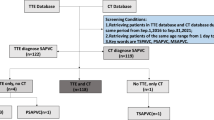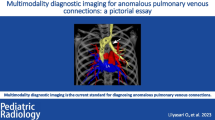Abstract
Background
Obstructed total anomalous pulmonary venous connection (TAPVC) is frequently misdiagnosed as pulmonary disease and without operative correction early death is common. It is important to make a correct diagnosis before surgery.
Objective
The purpose of this study was to describe the chest radiographic features of obstructed TAPVC and compare CT angiography with transthoracic echocardiography in the evaluation of obstructed TAPVC.
Materials and methods
Eighteen children with obstructed TAPVC were assessed. Their clinical and imaging data were retrospectively reviewed. The characteristic radiographic findings were analyzed and compared with surgical results, and the diagnostic accuracy of CT angiography and transthoracic echocardiography was evaluated in terms of pulmonary venous drainage and obstruction detection.
Results
The common radiographic features included pulmonary venous congestion or edema or both (16 of 18 cases, 89%), and absence of cardiomegaly (12 of 18 cases, 67%). CT angiography correctly diagnosed TAPVC and clearly revealed the draining sites in all children (five with supracardiac TAPVC, three with cardiac TAPVC, eight with infracardiac TAPVC and two with mixed TAPVC). The diagnostic agreement between CT angiography and surgery was 100%. Transthoracic echocardiography only correctly revealed the draining sites in 11 children (5 with supracardiac TAPVC, 2 with cardiac TAPVC and 4 with infracardiac TAPVC). The diagnostic agreement between transthoracic echocardiography and surgery was 61%. The diagnostic accuracy of CT angiography was higher than that of transthoracic echocardiography (P = 0.0156). Thirty-four sites of obstruction were correctly detected by CT angiography (11 in the mediastinum, 1 at the diaphragmatic level, 9 below the diaphragm and 13 stenotic individual pulmonary veins in the lung). The diagnostic agreement between CT angiography and surgery was 92%. Transthoracic echocardiography only correctly detected 15 sites of obstruction (11 in the mediastinum, 1 at the diaphragmatic level and 3 below the diaphragm). The diagnostic agreement between transthoracic echocardiography and surgery was 41%. The rate of detection for sites of obstruction with transthoracic echocardiography was much lower than that of CT angiography (P = 0.0002).
Conclusion
In children with obstructed TAPVC, plain radiographs usually show a characteristic pattern of pulmonary venous congestion or edema, or both, and a normal cardiac silhouette. CT angiography is superior to transthoracic echocardiography in the evaluation of pulmonary venous drainage and obstruction, especially in children with infracardiac and mixed TAPVC.








Similar content being viewed by others
References
Silverman FN (1993) Caffey’s pediatric X-ray diagnosis. Mosby, St. Louis
Craig JM, Darling RC, Rothney WB (1957) Total pulmonary venous drainage into the right side of the heart: report of 17 autopsied cases not associated with other major cardiovascular anomalies. Lab Invest 6:44–64
Swischuk LE (1997) Total anomalous pulmonary venous return. In: Swischuk LE (ed) Imaging of the newborn, infant, and young child, 4th edn. Williams & Wilkins, Baltimore, pp 239–245
Paul JF, Rohnean A, Elfassy E et al (2011) Radiation dose for thoracic and coronary step-and-shoot CT using a 128-slice dual-source machine in infants and small children with congenital heart disease. Pediatr Radiol 41:244–249
Goo HW (2012) CT radiation dose optimization and estimation: an update for radiologists. Korean J Radiol 13:1–11
Seale AN, Uemura H, Webber SA et al (2010) Total anomalous pulmonary venous connection: morphology and outcome from an international population-based study. Circulation 122:2718–2726
Goo HW, Park IS, Ko JK et al (2003) CT of congenital heart disease: normal anatomy and typical pathological conditions. Radiographics 23:S147–S165
Yang S (2005) Total anomalous pulmonary venous connection, TAPVC. In: Yang S (ed) Pediatric cardiology, 3rd edn. PMPH, Beijing, p 278
Stein P (2007) Total anomalous pulmonary venous connection. AORN J 85:509–520
Oh KH, Choo KS, Lim SJ et al (2009) Multidetector CT evaluation of total anomalous pulmonary venous connections: comparison with echocardiography. Pediatr Radiol 39:950–954
Ohtsuki S, Baba K, Kataoka K et al (2005) Usefulness of helical computed tomography in diagnosing pulmonary vein stenosis in infants. Acta Med Okayama 59:93–98
Kim TH, Kim YM, Suh CH et al (2000) Helical CT angiography and three-dimensional reconstruction of total anomalous pulmonary venous connections in neonates and infants. AJR Am J Roentgenol 175:1381–1386
Kawano T, Ishii M, Takaqi J et al (2000) Three-dimensional helical computed tomographic angiography in neonates and infants with complex congenital heart disease. Am Heart J 139:654–660
Liu J, Wu Q, Xu Y et al (2012) Role of MDCT angiography in the preoperative evaluation of anomalous pulmonary venous connection associated with complex cardiac abnormality. Eur J Radiol 81:1050–1056
Livolsi A, Kastler B, Marcellin L et al (1991) MR diagnosis of subdiaphragmatic anomalous pulmonary venous drainage in a newborn. J Comput Assist Tomogr 15:1051–1053
Dillman JR, Yarram SG, Hernandez RJ (2009) Imaging of pulmonary venous developmental anomalies. AJR Am J Roentgenol 192:1272–1285
Gulati G, Sharma S (2003) A rare form of supracardiac total anomalous pulmonary venous drainage-evaluation by computed tomography and magnetic resonance imaging. Clin Radiol 58:172–175
Acknowledgements
We appreciate the assistance of Drs. Xuecun Liang and Xiaojing Ma, Department of Echocardiography, Children’s Hospital, Fudan University.
Author information
Authors and Affiliations
Corresponding author
Rights and permissions
About this article
Cite this article
Shen, Q., Pa, M., Hu, X. et al. Role of plain radiography and CT angiography in the evaluation of obstructed total anomalous pulmonary venous connection. Pediatr Radiol 43, 827–835 (2013). https://doi.org/10.1007/s00247-012-2609-6
Received:
Revised:
Accepted:
Published:
Issue Date:
DOI: https://doi.org/10.1007/s00247-012-2609-6




